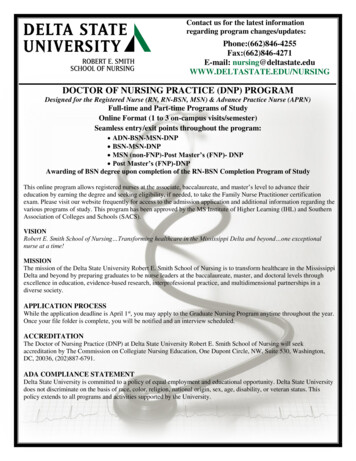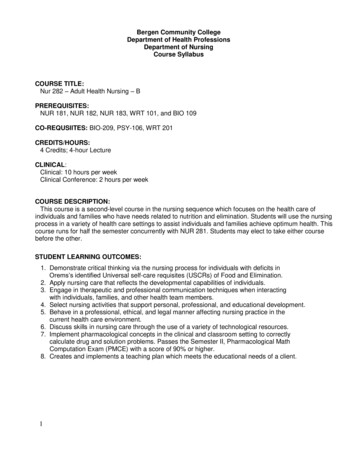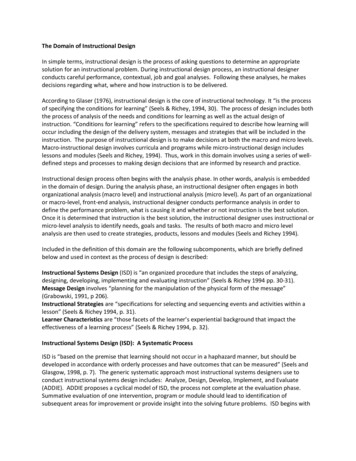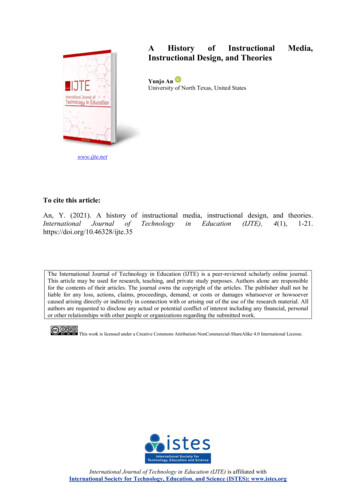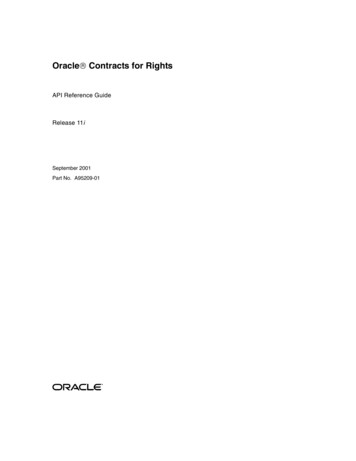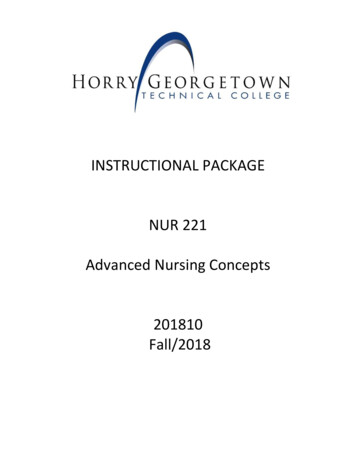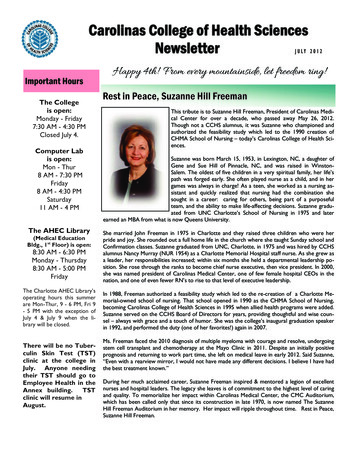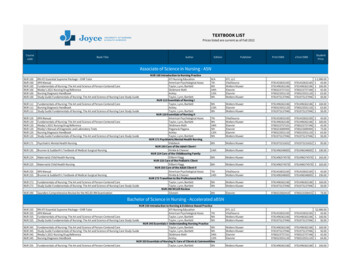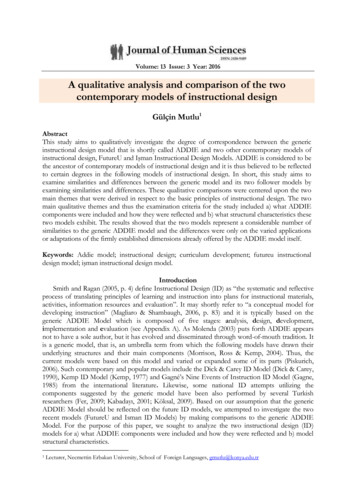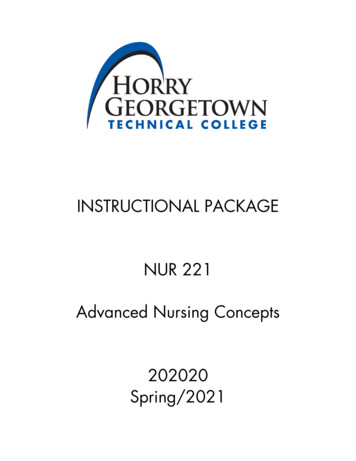
Transcription
INSTRUCTIONAL PACKAGENUR 221Advanced Nursing Concepts202020Spring/2021
INSTRUCTIONAL PACKAGEPart I: Course InformationEffective Term: 202020COURSE PREFIX: NUR 221COURSE TITLE: Advanced Nursing ConceptsCONTACT HOURS: 3CREDIT HOURS: 53.00 Lecture hours6.00 Lab hoursRATIONALE FOR THE COURSE:This course prepares the student to care for clients with life -threatening illness in a holisticmanner, understand the complexities of multiple comorbidities, meet the psychosocial needs ofclients and their families, provide holistic care to the dying client and increase participation inthe profession by involvement in disaster preparedness. The student will be exposed to multipleareas that will reinforce the behaviors inherent in practice as a professional nurse: criticalthinking, communication with adaptation to various barriers, professional behavior, andmanagement of client care, teaching/learning, incorporation of evidence based practice,clinical competence, and provision of culturally sensitive care.COURSE DESCRIPTION:This course expands the application of the nursing process throughout the lifespan in the careof clients experiencing complex health problems.PREREQUISITES/CO-REQUISITES:NUR 161NUR 217NUR 220SPC 205*Online/Hybrid courses require students to complete the DLi Online Student Orientation prior tocompleting an online course. The DLi Online Student Orientation can be found in WaveNet, under theMy Student tab.REQUIRED MATERIALS:Please visit the Bookstore online site for most current textbook information. Use the direct link below tofind.BOOKSTOREEnter the semester, course prefix, number and section when prompted and you will be linked to thecorrect textbook.April 2020
ADDITIONAL REQUIREMENTS:Karch Pharmacology 7th or 8th EditionNugent and Vitale, Test SuccessKaplan Nursing -The Basics.Complete HGTC student nurse’s uniformWristwatch with second handBandage scissorsPenlightStethoscopeEKG calipers or measuring cardTECHNICAL REQUIREMENTS:Access to Desire2Learn (D2L), HGTC’s student portal for course materials.WaveNet and D2L email access.STUDENT IDENTIFICATION VERIFICATIONStudents enrolled in online courses will be required to participate in a minimum of one (1) proctoredassignment and/or one (1) virtual event to support student identification verification. Please refer toyour Instructor Information Sheet for information regarding this requirement.CLASSROOM ETIQUETTE:As a matter of courtesy to other students and your professor, please turn off cell phones and othercommunication/entertainment devices before class begins. If you are monitoring for an emergency,please notify your professor prior to class and switch cell phone ringers to vibrate.ONLINE LECTURES:Please mute the microphone on the computer during on line lectures, and only unmute when you have aquestion.NETIQUETTE: is the term commonly used to refer to conventions adopted by Internet users on the web,mailing lists, public forums, and in live chat focused on online communications etiquette. For moreinformation regarding Netiquette expectations for distance learning courses, please visit OnlineNetiquette.Part II: Student Learning OutcomesCOURSE LEARNING OUTCOMES and ASSESSMENTS*:Upon completion of this capstone course (NUR 221) in the ADN curriculum, the student will beable to:1. SAFETYPromote a culture of safety within health care settings that minimizes the risk of harm to recipients andproviders of nursing care.April 2020
2. CLINICAL DECISION MAKINGFormulate effective clinical decisions, using analytical processes, which promote positive outcomes forrecipients of nursing care.3. TEAMWORK AND COLLABORATIONFacilitate coordinated patient care by integrating communication skills with inter-professionalcollaborative processes4. PROFESSIONAL BEHAVIORSModel behaviors that demonstrate accountability and reflect standards of the profession.5. PATIENT CENTERED CAREManage patient-centered care that values individual rights and needs while respecting diversity.Applicable to all units:DRUGS/ CALCULATIONS mcg/kg/min mL/hr. Units per hour patient safety patient comfort patient/family educationUnit 1Topics: Acute Coronary Syndrome, AAA,CABG, HIT, PTCA, and Cardiogenic ShockReadings: assigned per topicAssessment (s):Quizzes, class activitiesUnit examLearning Outcomes: Demonstrate advanced nursing skillsutilized in a comprehensive assessmentfor the client in a life-threatening state. Construct a template to identify riskfactors, associated disease processes,and related events that may precipitateAcute Coronary Syndrome. Differentiate the pain of different typesof angina and nursing interventions. Analyze and develop a plan to addressthe diagnostic laboratory results used indetecting and evaluating an AMI.April 2020Applicable to all units: psychosocial support SBAR Rhythm strip analysis HIPAA National Patient Safety Goals 2021 Critical thinking skills EKG interpretation Design the components of a cardiacrehabilitation program. Modify for the care of the clientundergoing a Percutaneous CoronaryIntervention based on comorbidities. Evaluate the components of the nursingmanagement of the client pre and postPCI. Formulate a nursing plan for the care ofthe client pre and postoperative CABGsurgery. Relate possible postoperativecomplications of CABG surgery to themedical and nursing therapies utilizedto recognize, prevent, and treat thosecomplications. Complete a nursing assessment, selecttherapeutic nursing interventions, andjustify the rationale in the client withand Acute Abdominal Aneurysm.
Interpret ECG changes related to angina and Acute Coronary Syndromeand formulate a plan of care.Design a plan of care outlining thenursing interventions related to the care of the client with an AMI and ACS incollaboration with the client.Select a list of and prioritize the nursing implications for specific cardiacmedications.Unit 2Topics: Acute Respiratory Failure, ARDS,Mechanical Ventilation, Sepsis, SepticShock, and Burns.Readings: assigned per topicAssessment(s):Quizzes, class activitiesUnit examLearning Outcomes: Analyze and prioritize appropriaterespiratory assessment measures,including physical assessment and labtests in the client with complex medicalneeds. Critically analyze ABG values andformulate a plan of care. Value the physiological, psychosocial,and spiritual effects of mechanicalventilation. Justify the nursing implications forprevention of complications related tomechanical ventilators Formulate a plan regardingpositioning, feeding, restraining, andsuctioning clients on mechanicalventilation. Unit 3Topics: Acute Liver Failure, Pancreatitis,Acute GI Bleed, Esophageal Varices, PortalHypertension, and Acute Kidney Injury.April 2020Compare and contrast thepathophysiologic alterations ofcardiogenic shock and hypovolemicshock.Differentiate subjective, objective, andphysical assessment data related tocardiogenic shock.Compare and contrast HIT and DICincluding signs, symptoms, treatments,and nursing implications.Relate the etiological factors andclinical manifestations of ARDS.Evaluate the plan of care for the clientwith ARDS related to mechanicalventilation, pharmacology, andnutrition.Compare and contrast methods tocommunicate therapeutically with theclient on mechanical ventilation.Justify the classification system used forassessing the adult with acute burninjuries.Analyze the major fluid and electrolytedisturbances found in the emergent andacute phases of burn care andformulate a plan of care.Select appropriate nursing interventionsrelated to the client with acute burninjury.Justify the use of the sepsis bundle tomanage and decrease risk factors forsepsis in the acute care setting.Critically analyze and formulate a planto address the risk factors for thedevelopment of sepsis.As part of a holistic assessment,compare and contrast the effects ofacute hepatic failure on the major bodysystems
Readings: assigned per topicAssessment:Quizzes, class activitiesUnit examLearning Outcomes: Compare and contrast the clinicalmanifestations of acute and chronicrenal failure. Evaluate the causes of and treatmentsfor acute kidney injury (AKI). As part of a holistic assessment,compare and contrast the effects ofrenal failure on all of the major bodysystems. Analyze and develop a plan of care toaddress the diagnostic test results usedto assess renal functioning. Formulate nursing interventions to assistclients who experience withdrawal ortoxicity from stimulants or depressants. Differentiate the rationale for specifictreatment modalities utilized for a clientwith AKI.Unit 4Topics: Disaster Management, Triage,Trauma, Spinal Cord Injury, TraumaticBrain Injury, Guillain Barre Syndrome,Increased Intracranial Pressure, BrainDeath/Organ Donation, SIADH, DIReadings: assigned per topicAssessments:Quizzes, class activitiesUnit examLearning Outcomes: Defend the legal/ethical issuesconcerning brain death in the care ofthe client with a traumatic brain injury. Select pain management modalitiesutilized with the trauma client. Evaluate the client’s therapeuticresponse to methods to improveoxygenation, perfusion, andApril 2020 Analyze and develop a plan of care toaddress the diagnostic test resultsindicative of altered liver function.Describe the medical management ofan acute GI bleed and esophagealvarices and defend the related nursingresponsibilities.Justify the surgical procedures andnursing interventions used to reduceportal hypertension.Evaluate the nursing management ofclients with hepatic encephalopathy.Create a plan of care for the client withacute pancreatitis.Appraise and prioritize the majorcauses of acute pancreatitis.Select the appropriate nursinginterventions for the client with acutepancreatitis.Evaluate the client’s therapeuticresponse to therapies and medicationsused in the treatment of pancreatitis.Develop a plan of care to address theprecipitating factors andpathophysiologic changes that occurwith increased intracranial pressure.Create a template to address a nursingassessment of a client with craniocerebral injury.Evaluate the signs of increasedintracranial pressure, and complicationsthat may occur.Select methods used to controlintracranial pressure and the relatednursing responsibilities.Compare and contrast the actions ofselected pharmacological agentsutilized in the treatment of craniocerebral trauma and/or increasedintracranial pressure.Appraise the client’s response to
ventilation.Critically analyze the priority needs ofthe client with trauma in both primaryand secondary surveys and formulate aplan of care.Compare and contrast thepathophysiology of a trauma basedupon mechanism of injury.Select the predisposing factors andargue the pathophysiology in GuillainBarre syndrome.Evaluate care of the client withGuillain-Barre, focusing on nursingassessment, interventions, andeducationCreate a plan of care for the client witha Spinal Cord Injury based on extentof injury.Evaluate the priority nursinginterventions needed for the client witha SCI.Prioritize the complications related tospinal cord injury and judge theappropriate nursing interventions.Value the physiological impact ofspinal cord injuries on sexual functionand discuss collaboration with teammembers. therapies and medications used tocontrol ICP.Differentiate various types of therapeuticcommunication techniques available foruse with the client and family in crises.Justify the role of the nurse in providingquality end-of-life care for clients acrossthe lifespan with consideration of ethicaland cultural issues.Defend the need for collaboration withinterdisciplinary team members whileimplementing the nursing role in end-oflife care.Argue the ethical issues and dilemmasthat may arise in end-of-life/palliativecare.Support the role of advance directivesin preventing ethical dilemmas.Examine the causes of grief and lossissues as they relate to complex ortraumatic circumstances.Apply the steps in triage, the primarysurvey, and the secondary survey to aclient with medical, surgical, ortraumatic emergency.*Students – please refer to the Instructor’s Course Information sheet for specificinformation on assessments and due dates.Part III: Grading and AssessmentEVALUATION OF REQUIRED COURSE MEASURES/ARTIFACTS*Students’ performance will be assessed and the weight associated with the various measures/artifactsare listed below.April 2020
EVALUATION*Students’ performance will be assessed and the weight associated with thevarious measures/artifacts are listed below.Unit Exams:Quizzes & AssignmentsFinal Exam:80%10%10%100%Students must achieve a minimum of 77 weighted points on the unit tests and final exam in order toprogress. The grade is calculated as follows: Unit test average X percentage and Final exam test gradeX percentage divided by 90.As an example:Unit test average77.54 X .80 62.03Final exam grade81.04 X .10 8.1Total points70.13 /90 77.9The remaining points from other assignments will be added once the grade of 77 or greater is achievedin order to calculate the overall theory grade. There is no rounding of any grades. Grades arecalculated to the hundredth decimal place.*Students, for the specific number and type of evaluations, please refer to theNUR 221 course calendar and the Instructor’s Course Information Sheet.GRADING SYSTEM:Because competency in nursing theory is a critical component for safe nursing practices, the gradingscale for nursing is higher than for some other courses. The grading scale for nursing is:90 – 100 A80 – 89 B77 – 79 C69 – 76 DBelow 69 FA grade of “C” is required all courses in the Associate Degree NursingProgram. Grades below “C” are considered course failures.Grades earned in courses impact academic progression and financial aid status. Before withdrawingfrom a course, be sure to talk with your instructor and financial aid counselor about the implications ofthat course of action. Ds, Fs, Ws, WFs and Is also negatively impact academic progression andfinancial aid status.The Add/Drop Period is the first 5 days of the semester for full term classes. Add/Drop periods areshorter for accelerated format courses. Please refer to the academic calendar for deadlines foradd/drop. You must attend at least one meeting of all of your classes during that period. If you do not,you will be dropped from the course(s) and your Financial Aid will be reduced accordingly.April 2020
Part IV: AttendanceHorry-Georgetown Technical College maintains a general attendance policy requiring students to bepresent for a minimum of 80 percent (80%) of their classes in order to receive credit for any course.Due to the varied nature of courses taught at the college, some faculty may require up to 90 percent(90%) attendance. Pursuant to 34 Code of Federal Regulations 228.22 - Return to Title IV Funds, once astudent has missed over 20% of the course or has missed two (2) consecutive weeks, the faculty isobligated to withdraw the student and a student may not be permitted to reenroll. Instructors defineabsentee limits for their class at the beginning of each term; please refer to theInstructor Course Information Sheet.For online and hybrid courses, check your Instructor’s Course Information Sheet for any requiredon-site meeting times. Please note, instructors may require tests to be taken at approved testing sites,and if you use a testing center other than those provided by HGTC, the center may charge a fee for itsservices.Part V: Student ResourcesTHE STUDENT SUCCESS AND TUTORING CENTER (SSTC):The SSTC offers to all students the following free resources:1.Academic tutors for most subject areas, Writing Center support, and collegesuccess skills.2.Online tutoring and academic support resources.3.Professional and interpersonal communication coaching in the EPIC Labs.Visit the Student Success & Tutoring Center website for more information. To schedule tutoringappointments using TutorTrac, visit the Student Services tab in WaveNet. Email sstc@hgtc.edu or callSSTC Conway, 349-7872; SSTC Grand Strand, 477-2113; and SSTC Georgetown, 520-1455, or goto the Online Resource Center to access on-demand resources.STUDENT INFORMATION CENTER: TECH CentralTECH Central offers to all students the following free resources:1. Getting around HGTC: General information and guidance for enrollment!2. Use the Online Resource Center (ORC) including scheduled technology training, Office 365support, password resets, and username information.3. Drop-in technology support or scheduled training in the Center or in class.4. In-person workshops, online tutorials and more services are available.April 2020
5. Chat with our staff on TECH Talk, our live chat service. TECH Talk can be accessed on thestudent portal and on TECH Central’s website, or by texting questions to (843) 375-8552.Visit the Tech Central website for more information. Live Chat and Center locations are posted on thewebsite. Or please call (843) 349 – TECH (8324).STUDENT TESTING:Testing in an online/hybrid course may be accomplished in a variety of ways: Test administered within D2L Test administered in writing on paper Test administered through Publisher PlatformsFurther more tests may have time limits and/or require a proctor.Proctoring can be accomplished either face-to-face at an approved site or online through RPNow, ouronline proctoring service. To find out more about proctoring services, please visit the Online Testingsection of the HGTC’s Testing Center webpage.The Instructor Information Sheet will have more details on test requirements for your course.DISABILITY SERVICES:HGTC is committed to providing an accessible environment for students with disabilities. Inquiries maybe directed to HGTC’s Accessibility and Disability Service webpage. The Accessibility and Disabilitystaff will review documentation of the student’s disability and, in a confidential setting with the student,develop an educational accommodation plan.Note: It is the student’s responsibility to self-identify as needing accommodations and to provideacceptable documentation. After a student has self-identified and submitted documentation of adisability, accommodations may be determined, accepted, and provided.STATEMENT OF EQUAL OPPORTUNITY/NON-DISCRIMINATION STATEMENT:Horry-Georgetown Technical College prohibits discrimination and harassment, including sexualharassment and abuse, on the basis of race, color, sex, national or ethnic origin, age, religion,disability, marital or family status, veteran status, political ideas, sexual orientation, gender identity, orpregnancy, childbirth, or related medical conditions, including, but not limited to, lactation ineducational programs and/or activities.TITLE IX REQUIREMENTS:All students (as well as other persons) at Horry-Georgetown Technical College are protected by TitleIX—regardless of their sex, sexual orientation, gender identity, part- or full-time status, disability, race,or national origin—in all aspects of educational programs and activities. Any student, or other memberof the college community, who believes that he/she is or has been a victim of sexual harassment orsexual violence may file a report with the college’s Chief Student Services Officer, campus lawenforcement, or with the college’s Title IX Coordinator, or designee.April 2020
*Faculty and Staff are required to report incidents to the Title IX Coordinators when involvingstudents. The only HGTC employees exempt from mandatory reporting are licensed mentalhealth professionals (only as part of their job description such as counseling services).INQUIRIES REGARDING THE NON-DISCRIMINATION/TITLE IX POLICIES:Student and prospective student inquiries concerning Section 504, Title II, and Title IX and their applicationto the College or any student decision may be directed to the Vice President for Student Affairs.Dr. Melissa Batten, VP Student AffairsTitle IX CoordinatorBuilding 1100, Room 107A, Conway CampusPO Box 261966, Conway, SC yee and applicant inquiries concerning Section 504, Title II, and Title IX and their application to theCollege may be directed to the Vice President for Human Resources.Jacquelyne Snyder, VP Human ResourcesEEO and Title IX CoordinatorBuilding 200, Room 212A, Conway CampusPO Box 261966, Conway, SC ril 2020
Intervention based on comorbidities. Evaluate the components of the nursing management of the client pre and post PCI. Formulate a nursing plan for the care of the client pre and postoperative CABG surgery. Relate possible postoperative complications of CABG surgery to the medical and nursing therapies utilized
